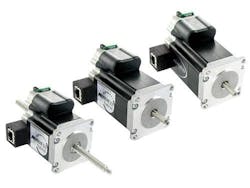For several years now, there’s been a clear trend of automation suppliers introducing more integrated motor/drive (IMD) products. These products now span the range of ac, dc, servo and stepper motor types, but are typically not used in heavy-duty applications.
Common applications now include everything from conveyor lines to CNC stonecutting saws and waterjets.
The all-in-one advantages of IMD products are expected to increase preference for IMDs among end users in manufacturing over the long-term, according to a recent report from research firm Frost & Sullivan. A principal reason for this is that the integration of a variable frequency drive (VFD) with a motor ensures efficient performance of the product, with efficiency levels typically exceeding 90 percent.
“This (efficiency in design) makes IMD units easier to deploy than procuring the motor and drive as two separate components and then combining them to achieve desired performance,” says Frost & Sullivan research analyst Ramasubramanian Natarajan. “It also reduces lag time and increases productivity.”
Despite such clear advantages inherent in IMDs, the report cited one major roadblock to their greater use in manufacturing — deployment of technology advances that enable higher power IMDs to be made available at a lower cost.
“Due to current technological limitations, above a certain point the physical size of the product makes the integration of motor and drives lose its meaning,” explains Natarajan. “While VFD solutions are clearly positioned to meet customer demands for higher power rating applications, IMD solutions are not yet perceived to be cost-effective at high power levels.”
To compete against low-cost IMD imports, Natarajan says that western IMD manufacturers could “outsource production of non-critical components to regions which offer low-cost labor and raw materials,” with the final IMD component being assembled and inspected by more skilled technicians.
Given the design efficiencies inherent in IMDs plus the boost in operations efficiency, “competitive price levels” (for IMDs) are key to boosting “demand for integrated motors and drives across key end-user industry segments,” Natarajan adds.
About the Author
David Greenfield, editor in chief
Editor in Chief
David Greenfield joined Automation World in June 2011. Bringing a wealth of industry knowledge and media experience to his position, David’s contributions can be found in AW’s print and online editions and custom projects. Earlier in his career, David was Editorial Director of Design News at UBM Electronics, and prior to joining UBM, he was Editorial Director of Control Engineering at Reed Business Information, where he also worked on Manufacturing Business Technology as Publisher.
Sign up for our eNewsletters
Get the latest news and updates

Leaders relevant to this article:
